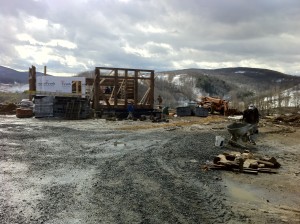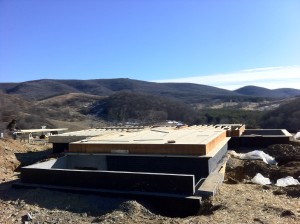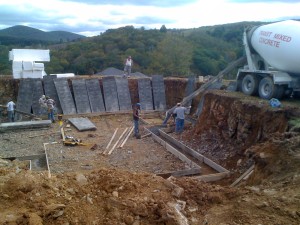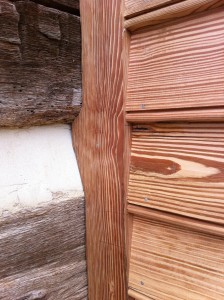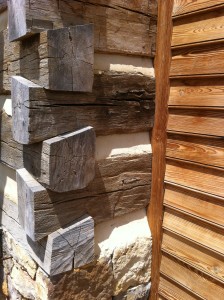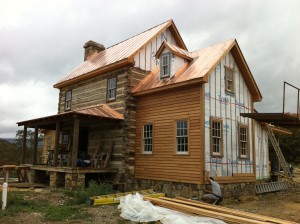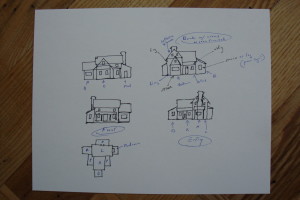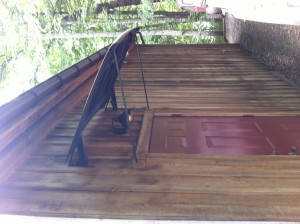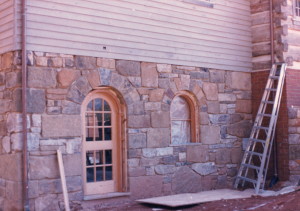And so it begins…
Noah Bradley2019-06-29T09:58:14+00:00I absolutely love this stage of construction.
At this point I had been working many months on this project, getting to know the site, working up the plans, acquiring various permits, and finding just the right materials.
The excavation is now done.
The concrete crew has come and gone.
We are back up out of the hole in the ground.
It’s time for the carpenters to do their magic. The site begins to smell of fresh sawn wood and the sounds of saws and hammers are heard across the property.
What has been envisioned in my mind and put on paper months ago is about to be revealed to the world. I can’t wait to see how it would turn out.
Life is good.
Originally posted 2015-07-05 15:08:03.
Building a basement
Noah Bradley2019-06-29T09:58:13+00:00Once the hole was completed it was time to fill it back in with a basement.
I am a big fan of poured concrete basements… either solid concrete as you see here through the use of temporary concrete forms, or by using Insulated Concrete Forms (ICF’s) (which are large hollow foam blocks that are laid and then the completed walls are filled with concrete).
I once witnessed a cinder-block basement wall collapse as it was being back-filled. Although a rare event, it was enough to convince me not to use them for basement construction.
I admire cinder blocks… the ugly little devils that they are. Cinder blocks are a cost effective manufactured marvels. Just don’t use them were they will ever be seen, nor to build a wall where any horizontal pressure is ever applied, such as a basement wall.
Originally posted 2015-07-05 14:45:53.
Look even closer
Noah Bradley2019-06-29T09:58:10+00:00Let’s look even closer at this corner.
The merging point, where an addition attaches to a log cabin, is always a challenging place to build correctly. Here the rigid lines of the addition meet the multiple materials and curved surfaces of the cabin.
I’ve seen some pretty sloppy examples over my years where differing structures come together and thus created opportunities for rot or even small creatures to enter the home.
Originally posted 2015-07-03 15:49:15.
Look close
Noah Bradley2019-06-29T09:58:09+00:00An old English carpenter once told me that people will rarely ever notice the details of something done correctly but are quick to spot something done poorly.
I’ve found that to often be true.
When a person builds a handmade home there are so many details that every inch of the home needs to be carefully crafted. All it takes is one lapse of craftsmanship and the entire home is degraded.
Every notch of the cabin needs to be tight. Every chink joint needs to be applied correctly. Even the often overlooked bead on the siding needs to be properly scaled.
Originally posted 2015-07-03 15:36:09.
More thoughts on home design
Noah Bradley2019-06-29T09:58:08+00:00And here is the view of this cabin from other end of the home.
Not bad huh? If I say so myself. 🙂
One of the faults I find with so many new house plans… and therefore, so many newly built houses… is that they always offer a view of the house straight-on from the front, but they never offer a corner perspective.
Think about it… how often do you stand perfectly centered in front of a house before you take a look at it? Or do you see a homeowner arrive home, park perfectly centered out front and walk straight to the front door?… never once peering even a bit around the side?
So, why are we presented… why do we pay attention only… to the front perspective of a home during the design phase? The answer is because all of the focus of most designers (and therefore future homeowners) is on the floor-plan. Once the room layout is completed the front elevation of the home is pimped-up with faux elements, and unfortunately the sides and back are given no consideration at all.
The end result? So many new homes are ghastly when viewed from the corners, or the other sides. The plans looked great… but the neighbors will forever view an eyesore.
OK… off of my soapbox… sorry about that…
There are a few details in this photo that I’d like you to notice…
The copper roof, the heart-pine beaded siding, and the hip roof on the front porch really add a lot of class to this home don’t they?… Like an evening gown on a fine lady… (almost all of my homes are she’s… sorry about that guys)
If you look closer, on the end where we were putting up siding you can see that we installed vertical strips of wood on the house before the siding went up so that a gap was created to allow the siding to equally breath on all sides. This siding will outlast us all, even if the owner chooses to do zero maintenance.
And, notice the copper flashing that we added above each window. Flashing should outlast a window, if flashing ever fails above a window, the window will soon fail as well. I’ve seen most modern flashing materials fail before their warranty ended, or shortly after, and thus resulting in the loss of those windows.
Originally posted 2015-07-03 14:50:59.
The first step in designing a home
Noah Bradley2019-06-29T09:58:07+00:00When I start the design process for the houses that I build I begin by “doodling”.
But first, before I put pen to paper, I go visit the site where the house will one day set. I listen to the client’s description of their wants and needs. I envision the house as it is seen from the road and how it will be seen upon approach by future guests. I take in the views and pay attention to the path of the sun and the direction of the wind. And, so much more.
Upon returning home, while the experience is still fresh in my mind I take out a piece of paper and just start “doodling” recalling the site that I had just visited and reflecting on the homes and cabins that had impressed me over the years.
As you can see, my main focus in these first sketches is almost entirely on elevations… on building a home that is attractive from the outside. Floor-plans, how the rooms are laid out, often fall into place as a home is built.
If I were allowed just one criticism of the current construction world… architects, builders, plan books, future homeowners, and kit-home suppliers, is the overemphasis on floor-plans and the lack of attention to the elevations.
Originally posted 2015-07-03 13:52:43.
Just one of the many advantages
Noah Bradley2019-06-29T09:57:59+00:00“We need to put a roof over the garage door.”
“I’ve got a hood off of an old Ford truck.”
“Perfect.”
One of the many advantages of building your own home is that you gain the skills, tools, and confidence to go on to build other things… like this client did when he went on to build his own garage after undertaking the completion of his log cabin.
And, when a person takes it to the next level, and builds a handmade house, they learn to “think out of the box” and explore unique possibilities… like using a salvaged truck hood for a little roof.
How cool is that?
Originally posted 2015-06-27 15:35:58.
On becoming a builder… part 11
Noah Bradley2019-06-29T09:57:38+00:00Who wouldn’t want a stone walk-out basement with arched entries?
Of course there is one minor fault which distracts me from fully enjoying all this workmanship. Allow me to ruin it for you… lol…
Whenever I build a stone arch I do my best to always start my arches on larger stones… the worst way to build an arch is by starting the arch on stones of the same size as those used in creating the arch… it visually ruins the effect by creating a run-on effect.
Notice the stone arch over the window and how it appears that the arch continues down the right side of the window creating an inverted “J” (or a candy cane) in the process.
Originally posted 2015-06-20 14:00:38.
On becoming a builder… part 10
Noah Bradley2019-06-29T09:57:37+00:00Here’s the other side of this incredibly nice home.
Who wouldn’t want a place as sweet as this?
But once again, there are a few details that make me cringe, that make me drop this cabin’s grade from an A to a B.
I’ll give the skylight a pass. A lot of people love these things. They can create some nice lighting effects, but boy do they tend to leak and they are a royal pain to clean.
If you look at the stonework on the chimney it appears as if the mason just gave up trying to properly lay the stone on the top six feet before he reached the brickwork. I’m not certain if he ran out of quality stone, or was losing money on his fixed bid, or was having problems in his personal life… but whatever it was it is clearly reflected in this chimney and will be forever.
Next up is the attic vents. These weren’t that noticeable in the previous photo due to shadows, but over here in the full sunlight we see these huge triangles. Vents that belong more on brick rancher than a vintage log cabin. I would have either vented behind the chimney, or put in vents that appeared to be two small windows, or not vented at all and simply made the attic space part of the conditioned interior.
There were no original windows in the end of this cabin. Both windows that you see in the photo were drawn in by the architect. I don’t know about how other’s view this but I find the diagonal placement of the windows to be distracting.
I would think no windows would have been fine. I would think four windows would have been better. I would think two windows on either floor would work. I would think two windows on either side of the chimney would have worked. I would think one window anywhere would have been fine. In other words… there are many pleasing ways the windows could have been designed into this cabin, and only one way to locate them wrong… and that, of course, is the way they were drawn. lol
Originally posted 2015-06-19 19:31:27.

